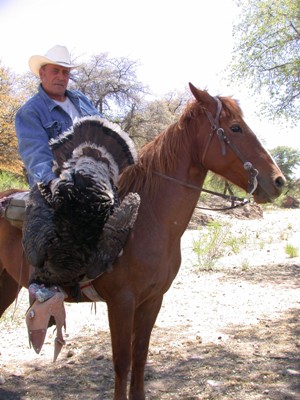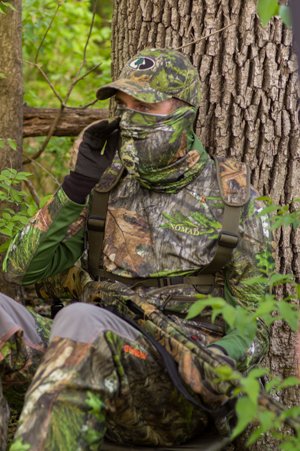with Jim Joint
 As I’ve mentioned earlier, our toughest hunts out here in South Dakota are always at the first of the season when the gobblers are usually roosting with and/or traveling with flocks of hens. However, in talking with other hunters or with people who own property where I’ll be hunting, I've learned a system that works fairly well for me. I attempt to learn from landowners or other hunters when they heard the first turkeys gobble. A farmer may say, “Last week I heard the turkeys gobble really hard on Monday. But then, they shut up, and I haven’t heard them gobble since then.” So, I go home, look at my calendar and mark the date when the landowner or hunter first heard turkeys gobble. I count 28-30 days and mark that date to start hunting. I know my hunting will get good after those 28-30 days, because usually after that period of time, the hens will go to nest.
As I’ve mentioned earlier, our toughest hunts out here in South Dakota are always at the first of the season when the gobblers are usually roosting with and/or traveling with flocks of hens. However, in talking with other hunters or with people who own property where I’ll be hunting, I've learned a system that works fairly well for me. I attempt to learn from landowners or other hunters when they heard the first turkeys gobble. A farmer may say, “Last week I heard the turkeys gobble really hard on Monday. But then, they shut up, and I haven’t heard them gobble since then.” So, I go home, look at my calendar and mark the date when the landowner or hunter first heard turkeys gobble. I count 28-30 days and mark that date to start hunting. I know my hunting will get good after those 28-30 days, because usually after that period of time, the hens will go to nest.
When I was working before I retired, I’d plan my vacation for the week or weeks after those 28-30 days. I knew that was when I had the best chance of being successful, since the hens would be nesting then. I still hunted during the early part of the season, but I took my vacation, so I could hunt all day when the hens were on the nest.
My toughest hunts always have been during the early season, right after the gobblers have established their pecking order, and they're staying with the hens from the time they fly down off the roost, until they fly-back up to the roost just before dark. The subordinate gobblers in a flock usually won’t gobble during that time, because they’ve been beat up by the dominant gobbler. The week before this interview with Mossy Oak in mid-April was our early season in South Dakota. Knowing that hunting would be tough, I still went out every morning. We heard plenty of turkeys gobble before daylight. But as soon as they hit the ground, they shut up, and we wouldn’t hear from them until I went out to listen for them flying up to the roost.
Normally, when we’re hunting at that time of the year, we won’t be able to get a turkey to gobble until maybe 9:00 or 10:00 am. But since we can hunt all day out here in South Dakota, I have a better chance of making a turkey gobble between 1:00 or 2:00 pm during the early season.
I’ve been asked, “How did you get to South Dakota?” I worked for General Electric in Nebraska for 37 years before I retired. I worked as an assembler for GE my first 30 years. During my last 7 years, I was a field technician. Some of my friends asked me, “Would you like to drive up to Deadwood, South Dakota, with us and go through the Black Hills?” I said, “Sure. I like to hunt, and I’d like to see what the Black Hills look like.” I was very impressed with the amount of game we saw and the beauty of the Black Hills. So, when I retired, I bought a place in South Dakota that backed up to the Black Hills.
I'm 62 years old and young at heart, but not so young as my hairline goes. So far this season, I haven’t missed a day of turkey hunting. I hunt in South Dakota, Pennsylvania, Missouri and Nebraska. I put in about 50 days of turkey hunting each year. I’ll start archery hunting for turkeys on April 1. Then when gun season comes in, I’ll hunt South Dakota or one of the other states until about May 21. Although I've only taken one turkey with a bow, I enjoy calling in turkeys for my buddies who archery hunt.




























